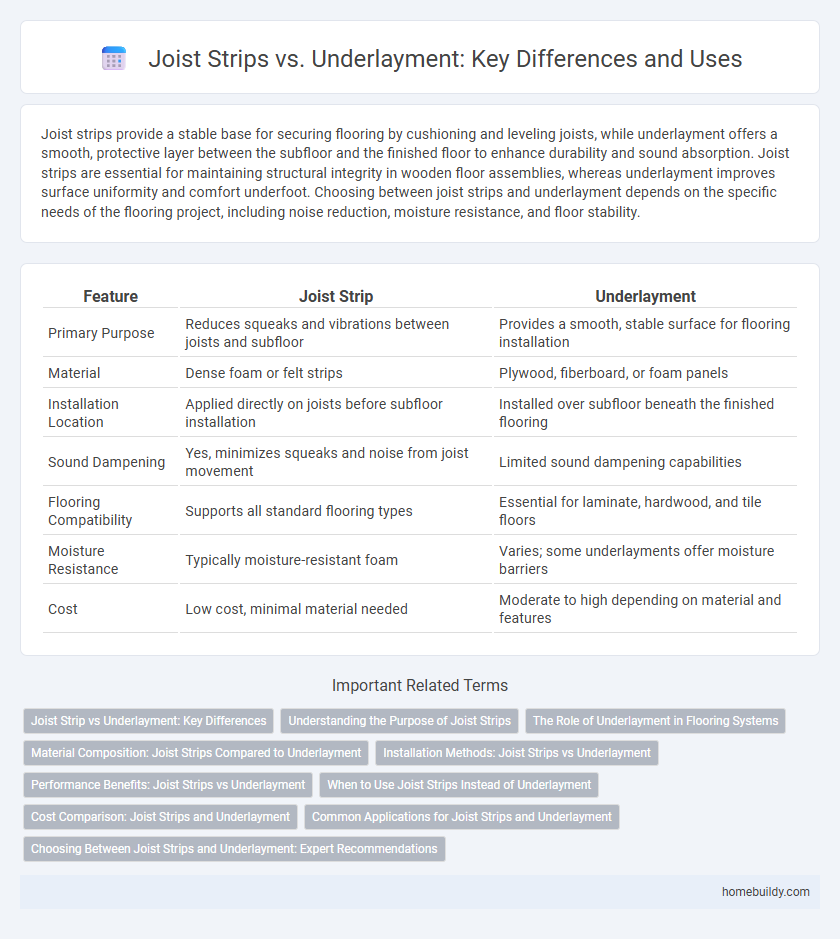Joist strips provide a stable base for securing flooring by cushioning and leveling joists, while underlayment offers a smooth, protective layer between the subfloor and the finished floor to enhance durability and sound absorption. Joist strips are essential for maintaining structural integrity in wooden floor assemblies, whereas underlayment improves surface uniformity and comfort underfoot. Choosing between joist strips and underlayment depends on the specific needs of the flooring project, including noise reduction, moisture resistance, and floor stability.
Table of Comparison
| Feature | Joist Strip | Underlayment |
|---|---|---|
| Primary Purpose | Reduces squeaks and vibrations between joists and subfloor | Provides a smooth, stable surface for flooring installation |
| Material | Dense foam or felt strips | Plywood, fiberboard, or foam panels |
| Installation Location | Applied directly on joists before subfloor installation | Installed over subfloor beneath the finished flooring |
| Sound Dampening | Yes, minimizes squeaks and noise from joist movement | Limited sound dampening capabilities |
| Flooring Compatibility | Supports all standard flooring types | Essential for laminate, hardwood, and tile floors |
| Moisture Resistance | Typically moisture-resistant foam | Varies; some underlayments offer moisture barriers |
| Cost | Low cost, minimal material needed | Moderate to high depending on material and features |
Joist Strip vs Underlayment: Key Differences
Joist strip acts as a cushioning layer placed directly on floor joists to reduce squeaks and improve sound insulation, while underlayment serves as a smooth surface layer installed over subfloors to provide moisture resistance, thermal insulation, and floor stability. Joist strips are typically made from foam or rubber materials, emphasizing noise reduction at the joist level, whereas underlayment options include foam, cork, or felt for enhanced comfort and protection under the final flooring. The choice between joist strip and underlayment depends on the specific needs of squeak prevention versus overall floor performance and comfort.
Understanding the Purpose of Joist Strips
Joist strips serve as a critical barrier between floor joists and subflooring, preventing moisture penetration and reducing the risk of structural damage. Unlike underlayment, which provides a smooth surface for finishing materials, joist strips primarily protect the integrity of the joist system by minimizing squeaks and settling. Proper installation of joist strips enhances floor stability and extends the lifespan of wood framing in residential and commercial construction.
The Role of Underlayment in Flooring Systems
Underlayment plays a crucial role in flooring systems by providing a smooth, level surface that enhances the performance of joist strips. It acts as a moisture barrier and sound dampener, preventing damage to joist strips and extending the durability of the flooring structure. Unlike joist strips, which provide structural support, underlayment primarily improves floor stability and comfort.
Material Composition: Joist Strips Compared to Underlayment
Joist strips are typically made from dense wood or engineered timber designed to provide structural support and distribute loads evenly across joists. Underlayment, in contrast, consists of materials like plywood, cement board, or fiberboard that create a smooth, stable surface for flooring installation. The material composition of joist strips emphasizes strength and durability for load-bearing purposes, while underlayment focuses on providing moisture resistance, sound dampening, and surface uniformity.
Installation Methods: Joist Strips vs Underlayment
Joist strips are installed directly onto floor joists to provide a fastening surface, enhancing structural support and reducing squeaks, typically requiring screws or nails for secure attachment. Underlayment is laid over subfloors to create a smooth, level base for finished flooring, often involving adhesive or stapling methods depending on the material type, such as plywood or foam. Installation of joist strips focuses on reinforcing joist integrity, while underlayment installation prioritizes surface preparation for optimal flooring performance.
Performance Benefits: Joist Strips vs Underlayment
Joist strips enhance floor stability by providing a solid fastening base that reduces floor flex and squeaking, unlike traditional underlayment which primarily offers surface smoothing and moisture resistance. Their rigid construction improves load distribution directly over joists, increasing structural integrity and extending floor lifespan. Underlayment often lacks the strength to address subfloor movement, making joist strips a superior choice for long-term performance and durability in flooring systems.
When to Use Joist Strips Instead of Underlayment
Joist strips are ideal when addressing uneven subfloor joists, providing a straight, level surface before installing flooring, unlike underlayment which primarily smooths out subfloor imperfections. Use joist strips in renovation projects where subfloor joists are damaged or warped, ensuring proper floor stability and alignment. Underlayment suits finished subfloors requiring minor leveling and moisture barriers, but joist strips are essential when structural correction is needed beneath the flooring system.
Cost Comparison: Joist Strips and Underlayment
Joist strips typically cost less than traditional underlayment materials due to their simpler design and installation process, making them a budget-friendly option for floor stabilization. Underlayment materials, such as plywood or cement board, involve higher material and labor costs but provide additional benefits like moisture resistance and sound insulation. Choosing between joist strips and underlayment depends on balancing upfront expenses with the desired structural and functional performance of the flooring system.
Common Applications for Joist Strips and Underlayment
Joist strips are commonly used in flooring systems to provide a stable base for hardwood or engineered wood floors, enhancing structural support and reducing floor squeaks. Underlayment serves as a cushioning layer beneath flooring materials like laminate, vinyl, or tile, improving sound absorption and moisture resistance. Both materials are essential in different stages of floor installation, with joist strips focusing on subfloor stability and underlayment prioritizing surface protection and comfort.
Choosing Between Joist Strips and Underlayment: Expert Recommendations
Joist strips provide targeted support by reinforcing beams and reducing squeaks, making them ideal for structural stability in wooden flooring systems. Underlayment offers a smoother surface for floor finishing, enhancing sound absorption and moisture resistance, suitable for leveling and protecting floor coverings. Experts recommend selecting joist strips when addressing subfloor movement and structural reinforcement, while underlayment is preferred for improving floor comfort and durability beneath laminate, hardwood, or vinyl flooring.
Joist strip vs Underlayment Infographic

 homebuildy.com
homebuildy.com